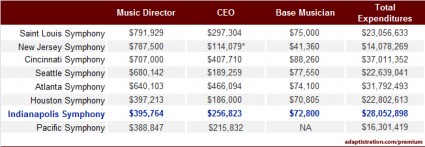Over the past few weeks, much has been written about the Indianapolis Symphony Orchestra’s (ISO) decision to not renew Music Director Mario Venzago’s contract after August 31, 2009. Although the sensitive phrase “not renew” was how the ISO described the decision, others across traditional and new media platforms have described it in less genteel language such as ouster, terminated, and fired. Although there has been much wailing and gnashing of teeth over the decision through the Indianapolis community and abroad regarding motives and process (some of which will likely come to the surface over the next few weeks), here are some facts you can use to begin drawing your own conclusions…
According to comments made by a representative from the agency that manages Venzago’s US engagements in an article by Jay Harvey in the 8/1/09 edition of IndyStar.com, negotiations broke down due to two key points:
A proposed 50 percent pay cut in Venzago’s salary as music director for the 2009-10 ISO season.
And a proposal that the music director’s salary be reduced to zero in 2010-11. Instead of a salary, he would be paid conducting fees — payment for his time on the podium leading the ISO.
Although the ISO has been making their financial troubles well known, details of which are dutifully included in the IndyStar.com article linked above, a 50 and 100 percent salary cut offer is practically unheard of. I was curious to see just how much Venzago earned compared to his peers at other US orchestras to see if such a sizeable cut is comparable to the sort of financial difficulties the ISO has made known. Granted, Venzago’s annual compensation up through the most recent season was quite handsome compared to average musician compensation but what I discovered is that it was nowhere near extraordinary compared to what music directors are paid.
I took the time to compare Venzago’s compensation levels with other ensembles that have the closest levels of total expenditures. Based on the latest available information (2006/07 season), even though the three closet peers to the ISO ($28.0 mil) by total expenditure were Atlanta ($31.7 mil), Pittsburgh ($31.7 mil), and Dallas ($26.7 mil) only one orchestra besides the ISO paid a music director for that season (Atlanta at $640,103). This and the fact that Venzago earned $244,339 less required an expansion of examination parameters.
For example, I took all music director compensation levels from the latest available data (2006/07 season) and sorted them by rank from highest to lowest. From there, I created a new comparison group defined on one end by the highest paid music director from an organization with total expenditures lower than the ISO and the first music director paid less than the ISO paid Venzago.
What I discovered is that among the orchestras in this list, most of those which paid their music director more than the ISO paid Venzago have smaller total expenditures. The following table is sorted by music director compensation (high to low) and illustrates what I uncovered. In order to provide a more comprehensive picture, I included the respective CEO and Base Musician compensation.

Of particular interest is comparing the music director compensation/total expenditure ratio between the ISO against ensembles such as New Jersey Symphony and St. Louis Symphony. In this list, the ISO’s music director compensation level is second from the bottom; however, other ISO stakeholders fared better.
When sorting this grouping by CEO compensation, the ISO executive ranked 4/8 and when sorting by base musician compensation, ISO musicians came in a bit lower at 5/8. At the same time, the ISO maintained the third highest total expenditure level. The following tables illustrate this data.



Based on all of this information, the notion that the ISO’s Music Director should accept a 50 and 100 percent pay cut in compensation in order to address the organization’s financial condition is curious given how much less Venzago was already being paid compared to his peers.
What remains intriguing about this situation, and we’ll have to examine at another time once more information is available, is whether or not Venzago’s involvement in fundraising activities had anything to do with the decision and if so, how much. Also worth examining is what appears to be a situation where the music director reports to the CEO, a remarkably rare occurrence in orchestras at the ISO’s level. If this is accurate then it adds a new level of intrigue into the process used to negotiate Venzago’s contract extension and the board’s role (or lack thereof) in that process.
Rest assured, given the highly charged nature of most public discussions on this topic (just Google “Venzago blogs“), this won’t be the last time we’ll be thinking about the ISO this fall. In the meantime, if you’re interested in doing some digging of your own into compensation levels at the ISO as far back as the 1999/00 season along with 75 more professional orchestras, get your very own subscription to Adaptistration Premium and be the insider.
Postscript: Thanks to my friend for suggesting today’s title when we were discussing this topic last week – you know who you are!



I’m confused. In the begining of the article you say most orchestras with similar operating budgets dont pay their music director. You then draw the conclusion that asking Venzago to take a paycut is “… curious given how much less Venzago is being paid compared to his peers…” I guess I don’t follow the logic of leaving the unpaid music directors out of the analysis.
Hi Ross, I think you may be confusing the excerpt from the IndyStar.com article which quotes Venzago’s manager commenting on a zero payment. I don’t beleive he was referring to anything other than the offer the ISO made to Venzago as there are no US music directors that earn zero dollars annual compensation for service at a professional orchestra.
If you’re referring to the part about Pittsburgh and Dallas, they were amid a music director search and had no single music director that worked for an entire season during that time, therefore had no payments recorded for a music director. Consequently, the text doesn’t indicate that those orchestras don’t pay music directors; rather, that there were no music directors in place at that time to pay. My apologies if that was unclear.